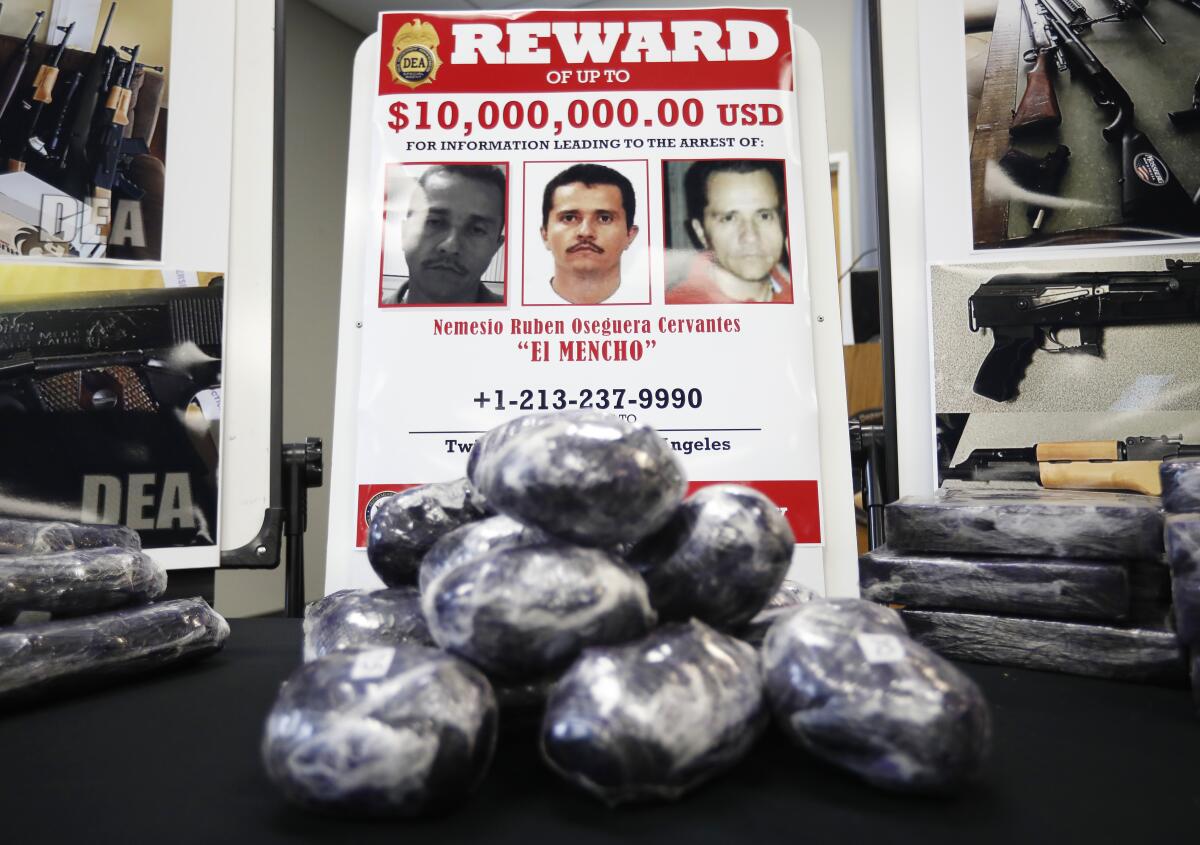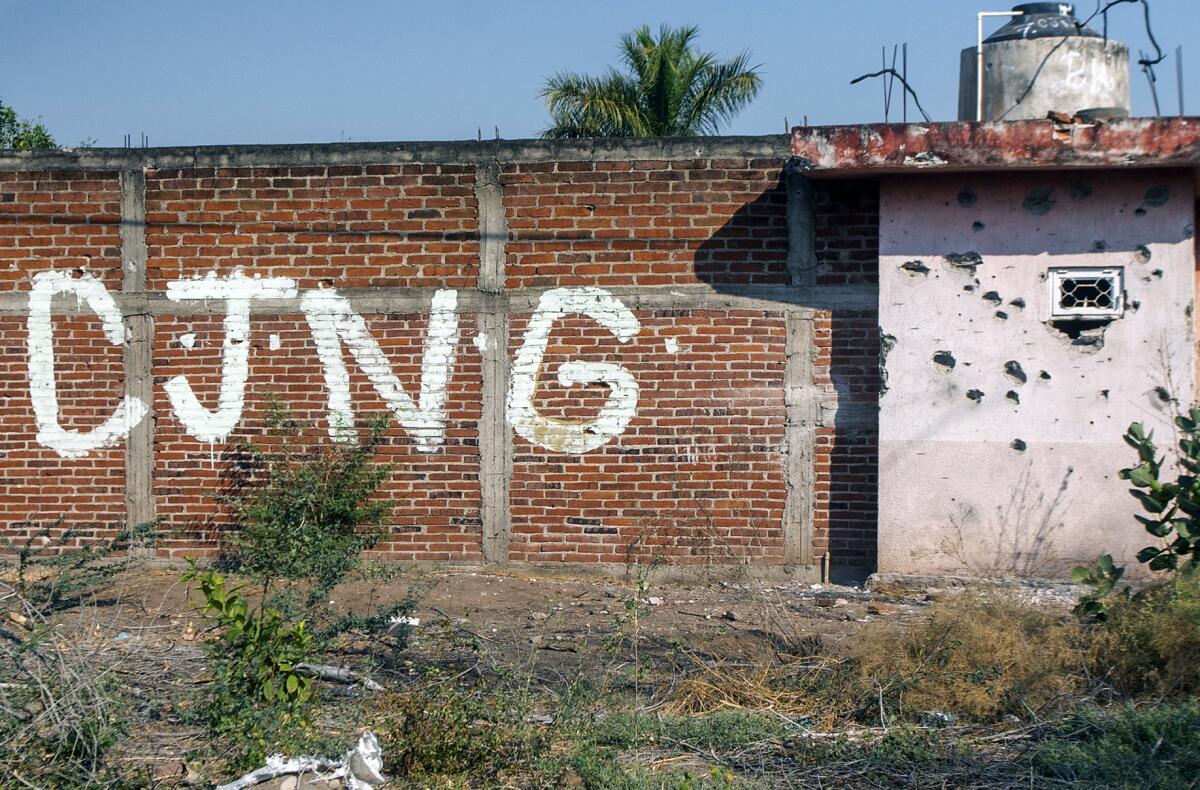
The reputed Mexican drug lord known as El Mencho has spent more than a decade evading efforts by U.S. and Mexican officials to bring him to justice. His son, alleged heir to one of Mexico’s biggest criminal empires, has not been so elusive.
Captured by Mexican law enforcement in 2015 — a month after henchmen allegedly operating under his orders shot down a military helicopter pursuing him and his father — he is now on trial in Washington on drug trafficking and weapons charges related to his alleged role in the Jalisco New Generation cartel.
Rubén Oseguera González, 34, better known as El Menchito, is part of a generation of “narco juniors” learning that the old-school codes of silence and family loyalty that once protected their fathers are increasingly relics of the past. He has faced damning testimony from a parade of former cartel members. Even his own uncle is expected to take the stand against him.
While other sons of other prominent Mexican traffickers have struck plea agreements — sometimes involving cooperation against cartel associates — court filings show Oseguera González rejected a deal last year. If convicted, he almost certainly faces life in prison.
The case has highlighted a generational divide between boomer-aged cartel bosses and their millennial kids.
The fathers often came from nothing and climbed the ranks to form their own cartels. Some of the juniors have attended private schools and rubbed shoulders with the future elites of their country. Now the privileged 30-somethings are increasingly taking on leadership roles as their dads — or at least those not killed or captured — near retirement age.
The offspring don’t have to look far to see that if they are caught and extradited to the U.S., choosing to go to trial is a high-risk, all-or-nothing gamble that rarely ends with walking free.
Exhibit A: Joaquín “El Chapo” Guzmán, longtime leader of the Sinaloa cartel, currently serving a life term under strict isolation at a remote Colorado prison dubbed the “Alcatraz of the Rockies.” Among the more than a dozen former associates who testified against him were two family members of his longtime partner, Ismael “El Mayo” Zambada.
Now, five years after El Chapo’s conviction, it seems his two of sons are seeking to avoid their father’s fate by any means necessary.
Mexican officials say Joaquín Guzmán Lopez, 38, and his brother Ovidio, 34, who was extradited to the U.S. last year, plotted to abduct Zambada in an effort to receive leniency in their own cases.
Zambada, who recently made his first court appearance in Brooklyn, N.Y., pleading not guilty to drug charges, has said he was “forcibly kidnapped” on July 25 when Joaquín hand-delivered him to U.S. agents at an airport near El Paso, where both men were arrested.
A lawyer for the brothers has denied they are cooperating. Both have pleaded not guilty and remain in custody with cases pending in Chicago and Washington for their alleged leadership of a cartel faction called Los Chapitos.
While El Chapo’s sons await their fate, Oseguera González is taking his chances before a jury.
In an opening statement last week, Justice Department prosecutor Jonathon Hornok laid out seemingly damning evidence — including anticipated testimony from a corrupt police chief who served as El Mencho’s personal bodyguard and others who trafficked drugs for the cartel, the CJNG, as it is known by its initials in Spanish.
“They are going to tell you about the birth of the CJNG, how they watched as the defendant’s father created the cartel, and how the defendant led the cartel as No. 2 alongside his father,” Hornok said.
Oseguera González’s counsel responded by telling jurors they should be skeptical of key witnesses “who have made that deal with the government” — an arrangement that he called “one of the underbellies of criminal justice.”
“It’s a wonderful system — it’s as perfect as it can get, but there are flaws,” said the attorney, Jan Ronis.
One observer of the narco-junior cases, David Weinstein, a former federal narcotics prosecutor in Miami, compared the wave of betrayals among Mexican cartel members to the erosion of New York’s Mafia families in the 1990s under federal racketeering investigations.
He cited the case of Salvatore “Sammy the Bull” Gravano, an underboss in the Gambino crime family who turned witness for the prosecution, helping to finally stick murder charges and a life sentence on the “Teflon Don,” John Gotti.
“There are certain people who just won’t testify, the family is thicker than anything: ‘I’m not going to be a rat and I’m not going to testify,’” Weinstein said. “Others say, ‘It’s not worth it. Even though it’s family, it’s not worth it.’”
Any chance of Oseguera González reaching a deal seemed to evaporate last year when he backed out of a plea at the eleventh hour after changing attorneys.
Court filings show Oseguera González signed documents admitting he ordered more than 100 murders.
Anticipated testimony described in pretrial filings said several victims were “drowned in a swimming pool.” Witnesses were also also expected to say he “personally shot and killed two people — a rival cartel member, and a subordinate who disobeyed orders.”
He oversaw a vast network of meth labs, prosecutors say, and allegedly procured weapons and military training from Russian mercenaries.
After Oseguera González canceled the deal, telling the judge at a hearing in April last year, “I just want a second opinion,” prosecutors were barred from using the plea admissions during the trial.
Arturo Hernandez, the defense attorney who took over representation of Oseguera González as he nixed the plea, said his client signed the documents without a Spanish interpreter present.
“That was absolutely unlawful,” said Hernandez, who is not part of the trial defense team. He added that he thought the plea documents becoming public before the trial “poisoned the jury pool” and would create an appellate issue if Oseguera González is found guilty.
Oseguera González’s other alleged activities included stealing fuel from pipelines in Mexico, which was resold and used to “pay CJNG hitmen to purchase weapons, equipment for methamphetamine production, and stolen cars” for the cartel, according to one court filing.
Prosecutors have said one witness will testify that Oseguera González boasted of amassing an “arsenal” that included .50-caliber sniper rifles, 40-millimeter automatic grenade launchers and shoulder-fired rocket launchers. They also allege that he “brokered and authorized the purchase of weapons from a Russian with a military background, who also was providing weapons training to the CJNG.”
Thousands of Blackberry Messenger communications obtained through wiretaps allegedly show Oseguera González conducting cartel business under handles that included “Forrest Gump,” “Ice Man” and “Billy the Kid.”
In one message, intercepted in October 2013, Oseguera González “agreed to release a chemist who had been kidnapped” so that he could manufacture oxycodone, a synthetic opioid often pressed into counterfeit prescription pills with fentanyl, according to prosecutors.
“I’m going to release him, brother,” the message said. “I’m just going to reach an agreement with him, so that he works with me.”

The U.S. Drug Enforcement Administration, which has said the CJNG “has presence in dozens of countries around the world and all 50 U.S. states,” is offering a $10-million reward for the capture of 58-year-old Nemesio Rubén Oseguera Cervantes — El Mencho.
As for Menchito, Eduardo Balarezo, an attorney who worked on El Chapo’s defense team and has been following the recent cases, said there’s only so much lawyers can do if a client insists on a trial when cooperators are lined up to testify.
“You can tell him what you think and give him your best advice, but sometimes they’re not listening to you, and that creates a problem,” he said.
“They’re going to try his father through him, basically,” Balarezo said. “And he’s going to get hammered. I can’t imagine they’re going to fare any better than Chapo, quite frankly.”